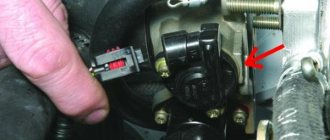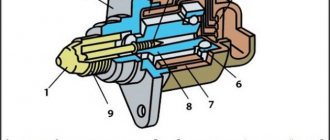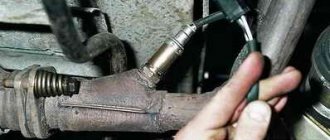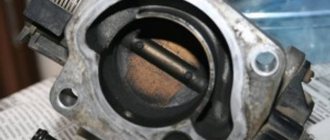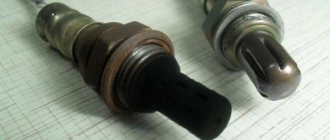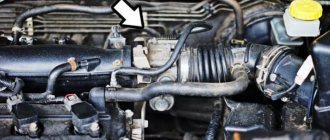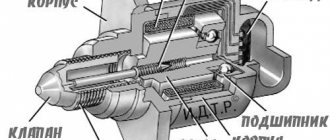The throttle position sensor on a Lada Priora car is necessary to determine the required amount of fuel depending on how open the throttle is. A signal is sent to the ECU and at this moment it determines how much fuel to supply to the injectors.
The TPS on the Priora is located in the same place as in all similar cars of the front-wheel drive VAZ family - on the throttle assembly in close proximity to the idle air control.
In order to replace this sensor, you will need very few tools, namely:
- short and regular Phillips screwdrivers
- Magnetic handle is preferable
Photo report on repairs
It is advisable, before any repairs related to the electrical equipment of the car, to disconnect the battery, for which it is enough to remove the negative terminal.
After this, slightly bending the latch of the plug lock, disconnect it from the throttle position sensor:
Then unscrew the two screws that secure the sensor itself to the throttle. Everything is clearly shown in the photo below:
And we can easily remove it after both screws are unscrewed:
The price of a new TPS for Priora ranges from 300 to 600 rubles, depending on the manufacturer. It is advisable to install one that matches the catalog number on the old factory sensor.
When installing, pay attention to the foam ring, which is clearly visible in the photo above - it should be without damage. We put everything in place and connect the wires that were removed.
The injection engine control system consists of a mass of interconnected sensors and detectors. Each of them regularly transmits data to the electronic control unit, and it already makes a decision on how much fuel to supply to the combustion chambers, how to adjust the ignition timing at a specific moment, what gear to engage in the automatic transmission and how to more rationally distribute torque among the axles and wheels if the car is all-wheel drive. We have gone far because today we are interested in one tiny sensor, without which the operation of a gasoline injection engine would be impossible. This is the throttle position sensor.
Content:
What is a throttle position sensor
Each of the sensors in the engine control system is a simple detector that is designed to perform one specific task. In our case, the position sensor determines the angle of movement of the throttle valve, which in turn repeats the movement of the accelerator pedal. For all its apparent simplicity, the sensor is not so simple, since it may have a simple contact design, or it may have a more complex and precise operating mechanism. More specifically, the sensors can be
- Contactless.
- Film resistive.
Resistive sensors are much simpler in design, cheaper, but also fail more often. They are almost an ordinary variable resistor with three contacts.
Operating principle of the sensor
To make it easier to understand the scheme of its operation, let’s imagine it this way, as a variable resistor mounted on the throttle valve axis with a moving part. Voltage is constantly supplied to the sensor, and depending on the position of the damper, the position of the sensor changes, and, consequently, its resistance also changes. It sends an impulse to the electronic control unit, which in turn, based on sensor readings, builds a recipe for supplying fuel to the combustion chamber - the amount of fuel, the amount of air, the ignition timing, the opening or closing of the exhaust gas recirculation valve. In short, based on the readings of this small sensor, the entire engine control plan for the next few seconds is prepared.
Regardless of the type of sensor, the voltage limit for its operation ranges from 0.5-5 volts, depending on the engine model. Injection cars VAZ 2110, 2112, Priora, Kalina use a working range from 0.7 to 4 volts. That is, when the throttle valve is completely closed, the pulse at the sensor output is 0.7 volts, and when it is fully open, it is 4 volts. Other cars may have different voltage characteristics, but the essence of the sensor’s operation does not change.
How to clean the throttle valve
There are a number of special products designed to clean the surface of the throttle valve. Some craftsmen use WD-40, acetone, solvents and other similar compounds for this. In principle, they can be used, but the risk of damaging something inside the engine increases. Today, car dealerships sell a large number of special products for carrying out this procedure. All of them are relatively inexpensive. Therefore, taking into account the fact that the throttle valve does not need to be cleaned so often, any car owner is able to purchase such a product.
| Name of the product | Description | average price | Notes |
| LIQUI MOLY DrosselKlappen-Reiniger (LM-5111) | The best throttle body cleaner available today. Cleans dirt and oil deposits efficiently. | 520 rub. | Aerosol, volume 400 ml in a cylinder. |
| Mannol Carburetor Cleaner | It cleans oil and dirt well from the valve. It costs less than ABRO, and the cylinder has a larger volume. | 115 rub. | Aerosol, volume 400 ml in a cylinder. |
| ABRO Carb&Choke Cleaner (CC-220) | High quality cleaner. Popular with car owners in our country. | 200 rub. | Aerosol, volume 220 ml in a cylinder. |
The cost is indicated as of prices for summer 2021 for Moscow and the region
Results
If the malfunctions described above occur, check the condition of the throttle valve. Cleaning it is not very difficult. However, if you clean it, the dynamic characteristics of the car will improve significantly. Therefore, do not forget to regularly clean the damper every 30.50 thousand kilometers. As for cleaning products, use any of the ones listed above. Fortunately, they are inexpensive, so they are available to any car enthusiast.
Ventilating the lungs or cleaning the throttle valve on a Priora. Today we will consider a topic with this name. It is, of course, more relevant for readers and drivers of the post-Soviet space, since this is where this car brand is most loved.
The throttle is essentially a metering device for supplying air to the combustion chamber for ignition with gasoline. The amount of injected fuel directly depends on how much is injected.
Maintenance and replacement of TPS
The practice of servicing and replacing the sensor does not change either. And all this is necessary when the diagnostic computer shows that the sensor is giving deliberately incorrect readings. Nobody repairs them; even expensive sensors are tried to be replaced entirely. Their job is too important to save on them. A faulty throttle angle sensor can manifest itself in a variety of ways. Since it works in all engine operating modes, it is not possible to immediately determine its malfunction by eye. In any case, when the first signs appear, which may include:
- instability of idle speed;
- failures when changing the speed;
- high fuel consumption;
- uneven acceleration;
- hard start,
and also in some cases when the emergency warning lamp is triggered, it would be useful to check the functionality of the sensor.
TPS Priora, signs of malfunction
In fact, symptoms indicating possible problems with the sensor can be different. The most common of them are given below:
- floating speed and unstable engine operation;
- twitching and jerking when accelerating;
- loss of power;
- arbitrary increase in engine speed;
- unstable idle;
- increase in fuel consumption.
If during the operation of the car you observe one or more of the above signs, then first of all you should pay attention to the TPS.
“You should remember! The sensor cannot be repaired, but simply replaced with a new, working product.”
Checking the position sensor
Before you check the throttle position sensor on any car, you need to estimate its average mileage. As a rule, contact sensors die already at 70-80 thousand km, while non-contact sensors last much longer. Therefore, if the sensor is old, it is better to immediately put it on the shelf and replace it with a new one. This pleasure is not so expensive, since back in 2015 you can buy a sensor for a Priora or dozens for 300 rubles. It will be either a Moscow or Kursk device. A sensor with the inscription “GM Made in Russia” is already offered for 800-900 rubles. Frankly speaking, there is not much difference, judging by the reviews.
TPS malfunctions on Priora
There are many different points that indicate possible problems with the throttle position sensor on the Priora. The main characteristic symptoms include:
- unstable idle speed;
- dips, jerking and unpredictable movements when accelerating;
- reduction in car dynamics and power;
- increase in fuel consumption;
- stalling engine.
Particular attention should be paid to the TPS if several of the listed points are being fulfilled at once. The easiest way to diagnose the sensor is to replace it with a new one. This element is extremely inexpensive, so buying a new one and installing it on the car will not be expensive.
However, it may turn out that the problem is not a faulty auto part, but the quality of the connections. To check the supply of stable power, you should disconnect the chip and measure the indicators with a multimeter.
This procedure must be done with the ignition on. If everything is fine with the power supply, then you need to carefully inspect the device again. A common failure is the loss of contact between the slider and the resistive layer.
Verification technology
To check the sensor, you first need to determine whether it is direct or reverse. So, on Daewoo Lanos cars, almost the same sensor is installed as on VAZs, only they work in different directions. That is, in the closed position of the damper it can produce 5 volts, or maybe 0.5 if the graphite contact tracks are turned in the other direction. Be that as it may, to check the sensor you need a multimeter and a couple of minutes of free time.
When connecting a multimeter to the sensor, it should show the minimum or maximum voltage, depending on the engine, and when rotating the throttle, change the voltage value smoothly and without jerking. If there is even the slightest dip in the readings in any range, the contact tracks have worn out and such a sensor must be replaced. That's all you need to know so that the throttle position sensor does not ruin our lives. Happy travels to everyone!
The degree of importance of every part of the car, be it an expensive steering mechanism or a cheap throttle position sensor of a Priora car, is difficult to overestimate, because the operation of the entire mechanism depends on the coordinated work of the parts.
TPS functions
The throttle valve is an element included in the engine intake system. Let us immediately note that the design of the throttle assembly is the same for both the 8-valve engine and the 16-valve engine. The meaning of its activity is to regulate the air entering the engine. The throttle position sensor transmits information to the manifold about the current state of the bypass valve. There are two types of sensors - magnetic (non-contact) and film. Its design is similar to an air valve, in which, when open, the system pressure and atmospheric pressure are identical; when closed, the pressure becomes close to vacuum.
The sensor includes a variable and constant resistor with a resistance of up to 8 ohms. The output voltage changes depending on how the damper is positioned. The system has control, thanks to which the fuel supply is regulated.
When the sensor is faulty and the readings are distorted, the fuel supply is disrupted, engine operation is disrupted, and in some cases the engine fails.
In addition, a working sensor will protect the gearbox and ignition switch.
Cleaning the throttle valve of a Lada Priora car
Our dear AvtoVAZ has been producing cars with injection engines for a long time. Such cars have been driving on our roads for about 10 years. During all this time, changes to the design and components have been made more than one hundred times and our cars have already begun to closely meet the standards of the European Union: the quality of engines and their efficiency increases, exhaust gases become noticeably cleaner, and all electronics are produced at one plant, and not Abroad.
However, our consumer is afraid of cars stuffed with electronics. This is influenced by the concept of service centers that has not yet taken root in our country, and by the general rejection of overly complex mechanisms. Over centuries of complex life, our mentality has become accustomed to the fact that everything should be simple and reliable, including machines. Previous generations of Lada cars, if you had the skill, could be disassembled and put back together in a day, and the presence of kilometers of wires and an on-board computer under the hood frightens the impossibility of self-repair. However, it is not such a technical complexity as paying for much lower fuel consumption that is attracting more and more buyers to VAZ cars, including the Priora model.
What can cause sensor failure?
There is nothing eternal in this world. Usually the TPS fails for natural reasons; the base along which the slide moves is simply worn out. Sometimes incorrect operation of the sensor is caused by the fact that the movable core fails. And damage to one of the tips entails the appearance of a number of scuffs, which can cause damage to the remaining parts. Ultimately, this can cause reduced or no contact between the slider and the resistive layer.
Signs of a car going into emergency mode:
- if at the moment of idling the revolutions “float”;
- if the engine stops when the pedal is abruptly released;
- if the speed hangs in the same range even when switching to neutral gear;
- if the Check engine light on the dashboard comes on.
Signs of sensor malfunction
When the TPS is in good working order, your vehicle operates without uncharacteristic jerking or jerking and quickly responds to pressing the gas pedal. If any of these conditions are not met, then there may be a sensor malfunction. This can be determined by the following signs:
- Starting the engine is difficult both hot and cold;
- Fuel consumption increases significantly;
- When driving, the engine jerks;
- At idle, the speed is often higher than normal;
- The car's acceleration is sluggish;
- Sometimes there are extraneous sounds similar to popping noises in the area of the intake manifold;
- The power unit may stall at idle;
- The Check indicator on the instrument panel blinks or stays on.
Most often, the sensor becomes unusable due to exceeding its service life due to wear-out. The contact group has a coating and, accordingly, it is characterized by wear. Those TPS that operate on a non-contact principle do not have this drawback and, accordingly, last much longer.
In order to finally make sure that it is necessary to replace this part, you need to be able to check the sensor .
How to check the throttle
Checking the throttle is a simple process. It is enough to have a multimeter or just a voltmeter. Adjustment can take place in your garage. To do this, the corrugated tube responsible for the air supply is disconnected, thoroughly washed with alcohol and wiped with a soft cloth. The same procedure is done with the intake manifold and the damper itself.
Inspect everything carefully. If there is no mechanical damage, the sensor is adjusted. Use a wrench to loosen the screws. The damper rises and drops sharply until it stops; If you don't hear the impact, you need to repeat it again. The screws are loosened until the product finishes “biting.” And only after that the fasteners are fixed with nuts. Then the TPS bolts are unscrewed and the housing is rotated, the sensor is set so that the voltage changes only when the damper is opened. Everything returns to its place, the bolts are tightened, the adjustment is complete.

